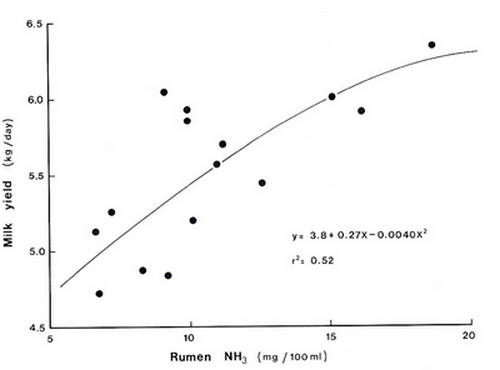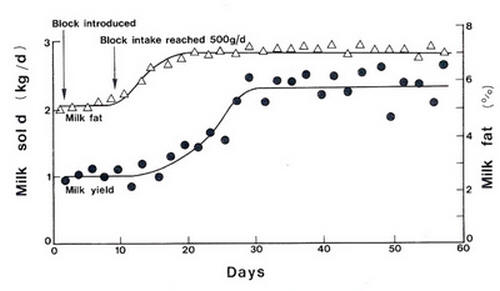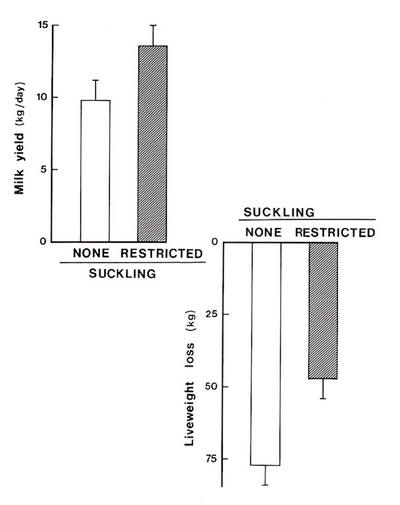Subsequent trials in Ethopia with crossbred cattle given a basal diet of low-N, low-digestibility hay plus 2kg daily of an oilseed-cake meal showed that milk yield and total dry-matter intake were increased when the animals consumed 700g of a molasses/urea (10%) block daily (Table 11.5). Animals that consumed the blocks had higher rumen ammonia concentrations.
|
Table 11.5: The effect of providing a urea/molasses block (10% urea) and 1 or 2 kg of noug (Guizotia abyssinica) cake on milk yield, liveweight change and feed intake of crossbred cows fed a basal diet of low-N and low-digestibility meadow hay. |
||||
|
|
1 kg noug/d |
2 kg noug/d |
||
|
|
No block |
+block |
No block |
+block |
|
Milk yield# |
4.2 |
5.4 |
5.2 |
5.4 |
|
LW, kg |
395 |
396 |
336 |
371 |
|
LW change (g/d) |
-640 |
-390 |
-270 |
-270 |
|
|
|
|
|
|
|
Intake (kg/d) |
|
|
|
|
|
Hay* |
8.7 |
9.6 |
8.8 |
9.3 |
|
Block |
|
0.7 |
|
0.7 |
|
Noug |
1 |
1 |
2 |
2 |
|
Total* |
8.8 |
10.1 |
9.7 |
10.7 |
|
Source:
T R Preston,
R A Leng
and M
Nuwanyakpa,
unpublished
data.
|
||||
There was a significant relationship between milk yield and rumen ammonia concentration (see Figure 11.1).
 |
|
Figure 11.1: Relationship between rumen ammonia before feeding and adjusted milk yield in crossbred cows fed a basal diet of low-N hay and 2kg of an oilseed cake/day, with or without access to urea/molasses block (Source: T R Preston, R A Leng and M Nuwanyakpa, unpublished data') |
Safety in the use of blocks or liquid supplements
At the beginning of the Indian project considerable concern was expressed by the technical advisors about the possibility of over-consumption ofthe block and therefore danger of ammonia toxicity. Initially the blocks were prepared with only 10% urea. Subsequently 15% urea blocks have been used.
When blocks are first introduced to adult buffaloes and cattle on straw-based diets, about 50% of the animals adapt immediately while others take up to 14 days before they consume appreciable quantities. Animals that adapt quickly often consume large amounts of the block, although intake appears to be fairly regular over 24 hours.
Several thousand buffaloes in village herds have been fed urea/molasses blocks containing 15% urea, with considerable increases in productivity. Ammonia toxicity has not been a problem, apparently because of the slow rate of intake. Buffaloes have been maintained throughout pregnancy and lactation on a
diet supplemented with the blocks and have successfully conceived a second time, indicating that there are no ill effects which might appear in the long term from t.he use of the block.
Ammonia toxicity from urea feeding has been overemphasised mainly because of lack of understanding of the principles underlying the efficient utilisation of urea in feeding systems (see Chapter 7). The important point is that when urea is given in a liquid mixture with molasses, only the minimum amount of water needed to dissolve the urea should be added (preferably none if a suitable mechanical mixer is available). Under these conditions the concentration of urea in the molasses can be as high as 20% and the mixture can be offered free choice with safety. As with any new feed, urea/molasses mixtures, either as liquids or as blocks, are best introduced to animals that are not hungry (eg. in the evening after a day's grazing, or after the roughage portion of the diet has been eaten).
Village studies
Both the animal production and socio-economic aspects of the block technology are now being extensively evaluated in villages in India (Table 11.6). In several villages, records have been kept of milk yield prior to and after introduction of a commercial multinutrient block.
|
Table 11.6: Average daily milk and fat yields from before and after the introduction of molasses/ul'ea blocks to buffalo in villages in the Kaira Milk Producing Union Ltd., Anand, India. |
||||
|
|
Milk yield (kg/d) |
Milk fat (g/d) |
||
|
|
No block |
Block |
No block |
Block |
|
Village |
|
|
|
|
|
Alwa |
4.8 |
5.9 |
330 |
450 |
|
Punadhara |
4.0 |
4.8 |
270 |
340 |
|
Fulgenamuwada |
2.4 |
3.5 |
160 |
280 |
|
Hirapura |
4.2 |
5.2 |
350 |
480 |
|
Banroli |
3.6 |
4.2 |
270 |
380 |
|
Dehgam |
4.3 |
4.7 |
310 |
350 |
|
Source: Kunju (1986). |
||||
The research indicates that:
-
Where large amounts of concentrates (46kg/ day) were fed to dairy buffaloes, introduction of the block allowed the farmer to reduce the amount of concentrates fed by 2 to 4kg/day (NDDB 1982-83), thus increasing profitability
-
Where buffaloes were largely maintained on straw with little supplementation, the introduction of the block resulted in marked increases in straw intake and an increase in milk yield of 50100%. A typical result from data taken from the records of the sales and composition of milk is shown in Figure 11.2. Milk yield was increased from about 1.5 to 2.4 litres/day and, consistent with the effects of stimulating rumen fermentation (ie. increasing microbial protein production and therefore availability of fat and glucogenic energy in the fermentation end-products), the fat concentration of the milk increased.
 |
|
Figure 11.2: The effects of introducing a molasses/urea blod~ (20% U1·ea) to a milking buffalo in a village in Mehsana, Gujarat, India. It took approximately 8 days before the buffalo consumed significant amounts of the block (500 g/d). Milk yield and fat content increased after· a time lag of 7-10 days. The basal dlet was straw from millet with a "handful" of green forage (Source: G Kunju, A Dave and R A Leng, unpublished data). |
The increase in milk fat when the nutrient block was provided to buffaloes is consistent with an increased efficiency of synthesis of microbial cells in the rumen. The increased availability of microbial protein and fat relative to acetogenic nutrients (acetate and propionate) accounts for the im proved fat deposition in milk. In previous cakulations (see Table 4.4) the effect of creating an efficient microbial ecosystem by providing the deficient nutrients in a straw-based diet was to increase intake from 10 to 14kg straw / d and microbial cell production in the rumen from 0.83 to 2.33kg DM/d. Because microbes are 10% lipid this would increase the availability of long chain fatty acids by 150g/d or about the same increase in fat yield in milk brought about by supplementation with a molasses/urea block.
So far, the research and development activities with urea/molasses blocks have been mostly confined to tetlH'red animals. For ruminants grazing on communal lands and housed and fed crop residues at night, the block may be fed in the pens or sheds. However, when the pasture is dry and low in N it is preferable that the blocks accompany the animals to the grazing areas so that they are always available.
11.3 Restricted suckling
In Chapter 2, attention was focussed on the interaction between systems of calf rearing and the use of crossbred cows for milk production. Crossbreeding native cows using imported semen of specialised dairy breeds is the strategy most frequently advocated for establishing a dairy industry in developing countries. As part of the "technological package" it is usually advocated that calves are removed from their dams within a few days of birth and bucket-fed, either with cow's milk or with a milk substitute. This policy is being increasingly questioned (Preston 1977) as being inappropriate under the conditions of feeding and management in most developing countries. Restricted suckling appears to be a more viable option (Preston 1983a) because it results in increased production of both the dam and the offspring (Table 11.7, Table 11.8, Table 11.9 and Table 11.10).
|
Table 11.7: Effect of restricted suckling on milk yield of cows. Comparisons were mostly during early lactation (8-12 weeks) or until the calves were weaned |
||||||
|
Breed |
Reference |
Bucket |
Calf |
Total |
Milk yield (no calf) |
|
|
Lactation yield (kg) |
|
|
|
|
||
|
Cross breed |
1 |
910 |
560 |
1470 |
218 |
|
|
Holsteinb |
2 |
3424 |
- |
3424 |
2340 |
|
|
Holsteinb |
3 |
1598 |
- |
1598 |
1463 |
|
|
Daily milk yield (kg/d) |
|
|
|
|
||
|
Holstein |
1 |
6.2 |
6.9 |
13.1 |
10.7 |
|
|
Holstein |
2 |
7.8 |
6.8 |
14.6 |
9.7 |
|
|
F1 (Holst.xZebu)b |
3 |
3.9 |
6.6 |
10.2 |
6.3 |
|
|
Sahiwal |
4 |
4.3 |
2.7 |
6.9 |
2.7 |
|
|
Creole |
5 |
7.9 |
2.7 |
10.6 |
8.8 |
|
|
Hereford x Holstein |
6 |
4.5 |
3.9 |
8.4 |
4.9 |
|
|
1.
Alvarez
et
a1.
(1980)
2.
Paredes
et a1.
(1981)
3.
Ugarte
and Preston
(1975)
|
||||||
|
Table 11.8: Friesian/Sahiwal cattle in Malaysia were milked by hand with the calf at foot (Normal System) or by machine without calf stimulation ("Improved" System). Total milk produced per lactation was much higher in the former system, mainly because lactation was prolonged in the hand milking/restricted suckling system. |
||
|
|
Normal System |
"Improved" System |
|
Milk, kg/lactation# |
1860 |
1410 |
|
Lactation, d |
330 |
229 |
|
Calving interval, d |
438 |
419 |
|
Source:
Cheah
and Kumar (1984).
|
||
|
Table 11.9: Mastitis incidence in crossbred Holstein and Brown Swiss/Zebu cows was reduced when they were milked with the calf given restricted suckling. |
||
|
|
No |
Restricted |
|
No. of cows |
45 |
47 |
|
Mastitis incidence (%)# |
|
|
|
Negative |
54 |
77 |
|
Suspicious |
13 |
14 |
|
Positive |
32 |
7 |
|
Clinical cases |
7 |
0 |
|
Lost quarters |
2 |
0 |
|
Source:
Alvarez
et
al. (1980).
|
||
|
Table 11.10: Growth rate of calves and conversion of milk into liveweight gain are improved when calves are reared by restricted suckling (RS) rather than with milk from a bucket (artificial rearing AR) |
|||||
|
|
|
Calf growth (g/d) |
Conversion# |
||
|
|
Ref. |
RS |
AR |
RS |
AR |
|
Crossbreeds |
1 |
464 |
277 |
|
|
|
Holstein |
1 |
770 |
500 |
7.8 |
8.0 |
|
Sahiwal & AIS crosses* |
2 |
552 |
370 |
5.0 |
9.0 |
|
Creole |
3 |
317 |
413 |
8.4 |
9.3 |
|
HerefordxHolstein |
3 |
497 |
353 |
7.8 |
1l.4 |
|
Buffaloes |
4 |
463 |
330 |
6.2 |
8.5 |
|
# Milk
consumed
by
the
calf/weight
gain
(kg/kg) |
|||||
Most calves in developing countries are expected to obtain most of their nutrients from the cheapest and most available resources such as low-N pasture and crop residues. In this situation, restricted suckling allowing the calf to consume a small amount of milk, which bypasses the rumen completely and is a balanced combination of essential amino acids, glucose and long-chain fatty acids-enables the calf to grow at a satisfactory rate on basal diets which, if fed alone, would not support maintenance. The actual cost of allowing the calf this vital supplement is very small because the calf is only allowed to suckle after the cow has been milked. Restricted suckling also appears to stimulate the cow and may increase the total amount of milk produced by the cow (Table 11.7, Figure 11.3).
 |
|
Figure 11.3: Holstein cows m Venezuela milked by machine and with restricted suckling of their own calves after milking gave more milk and lost less bodyweight after calving than cows whose calves were removed after 3 days and reared artificially (Source: Velazco et al. 1982a). |
In tropical climates, the most appropriate animals for producing milk are buffaloes and crossbred cows, since they have the necessary reproductive capacity and the tolerance to environmental stress. In these situations, milk must be produced against a background of moderate nutrition (eg. basal diets of crop residues and low-N pasture) and a hot, often humid climate where there is usually a continuous challenge from vector-borne diseases. The proportion of 'indigenous' genes (usually Bos indicus) in the crossbred cow almost certainly should never be less than 50%. A characteristic of this type of animal is that both milk 'letdown' and persistency of milk production are poor compared with specialised dairy breeds from temperate areas unless the calf is present at the time of milking.
The contrast between the systems for rearing calves in industrialised and developing countries must be understood. In the former, artificial rearing is the system of choice, but this is conditioned by the availability of milk substitutes formulated from a variety of products including skim-milk powder, buttermilk powder and tallow, and which can be purchased at less than the farm-gate price for whole milk.
These liquid feeds are supplemented with, and gradually replaced by, high-quality dry feeds based on cereal grains and oilseed and animal byproduct meals. Feeds such as straw and dry pastures are never an important source of nutrients during the calf's early growth period.
In addition, the specialised dairy breeds let down their milk as readily to machines as to calves and milking systems have been devised that enable a high output of milk per unit of labour (which is expensive). Thus, artificial rearing is "appropriate" in the industrialised countries.
11.3.1 Conclusions
For developing countries, the advantages of restricted suckling of calves are many and include:
-
Milk 'letdown' is stimulated whether the milking is done by hand or machine
-
Milk yield is increased by up to 30% (Table 11.6 and Table 11.8)
-
Cows that continue to suckle their calves lose less bodyweight after calving (Figure 11.3).
-
Growth rate and health of the calf are improved considerably in comparison with animals given the same amount of milk from a teat or a bucket (Table 11.10)
-
There is little or no effect on reproductive rate (Table 11.11).
|
Table 11.11: Effects of restricted suckling (RS) or artificial rearing (AR) of calves on time to first oestrus and inte1'Calving intel'val of the dam. |
|||||
|
|
|
First oestrus (d) |
Calving interval (d) |
||
|
Breed |
Ref. |
AR |
RS |
AR |
RS |
|
Holstein |
1 |
|
|
352 |
352 |
|
F1(HolxZebu) |
1 |
|
|
336 |
343 |
|
F1(HolxZebu) |
2 |
- |
84 |
- |
350 |
|
Holstein |
3 |
89 |
90 |
365 |
373 |
|
HolxZebu |
4 |
|
|
|
380 |
|
F1 HolxZebu |
5 |
|
|
399 |
422 |
|
Hol/SwissxZebu |
6 |
- |
- |
474 |
416 |
|
Holstein |
7 |
65 |
66 |
392 |
394 |
|
1. Ugarte and Preston (1972) 2. Veitia and Simon (1972) 3. Ugarte and Preston (1975) 4. Fernandez et al. (1977) 5. Ugarte and Maldonado (1979) 6. Alvarez et al. (1980) 7. Paredes et al. (1982) |
|||||